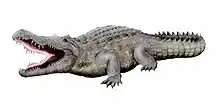| "Crocodylus" gariepensis Temporal range: Early Miocene, | |
|---|---|
| Scientific classification | |
| Kingdom: | |
| Phylum: | |
| Class: | |
| Order: | |
| Superfamily: | |
| Family: | |
| Subfamily: | |
| Genus: | |
| Species: | †"C." gariepensis |
| Binomial name | |
| †"Crocodylus" gariepensis Pickford, 2003 | |
"Crocodylus" gariepensis is an extinct species of crocodile that lived in southern Africa during the Early Miocene[1] about 17.5 million years ago (Ma).[2] Fossils have been found along a bank of the Orange River in Namibia, near its border with South Africa.[1]
Classification and Phylogeny
When the species was named in 2003,[3] it was hypothesized to be ancestral to the living Nile crocodile, Crocodylus niloticus. During this time the fossil record of C. niloticus was thought to extend back into the Late Miocene, meaning that "C." gariepensis could have been a direct precursor to the species.[4] More recent studies propose that C. niloticus first appeared much more recently, making "C." gariepensis an unlikely ancestor of the Nile crocodile. Moreover, the most recent phylogenetic studies of crocodiles place "C." gariepensis in an evolutionary position outside other living species of Crocodylus, far from the position of C. niloticus. Indeed, the species appears to be an osteolaemine more closely related to dwarf crocodiles (Osteolaemus) and possibly slender-snouted crocodiles (Mecistops), as shown in the cladogram below:[5]
| Crocodylidae |
|
Paleoafrican Crocodylus Neotropical Crocodylus Indo-Pacific Crocodylus | ||||||||||||||||||||||||||||||||||||||||||||||||||||||||||||||||||||||||||||||||||||||||||||||||||||||||||||||||||||||||||||||||||||
Paleoecology
Although much of Namibia is currently arid, "C." gariepensis lived during a time when the local climate was humid and subtropical. It likely inhabited gallery forests surrounding the Orange River. Fossils of giant tortoises and a variety of small burrowing mammals have been found in the same deposits.[2]
References
- 1 2 Brochu, C. A.; Storrs, G. W. (2012). "A giant crocodile from the Plio-Pleistocene of Kenya, the phylogenetic relationships of Neogene African crocodylines, and the antiquity of Crocodylus in Africa". Journal of Vertebrate Paleontology. 32 (3): 587–602. doi:10.1080/02724634.2012.652324. S2CID 85103427.
- 1 2 Senut, B.; Pickford, M.; Ségalen, L. C. (2009). "Neogene desertification of Africa". Comptes Rendus Geoscience. 341 (8–9): 591–602. Bibcode:2009CRGeo.341..591S. doi:10.1016/j.crte.2009.03.008.
- ↑ Pickford, M. (2003). "A new species of crocodile from Early and Middle Miocene deposits of the Lower Orange River Valley, Namibia, and the origins of the Nile crocodile (Crocodylus niloticus)" (PDF). Memoirs of the Geological Survey of Namibia. 19: 51–65.
- ↑ Delfino, M.; Segid, A.; Yosief, D.; Shoshani, J.; Rook, L.; Libsekal, Y. (2004). "Fossil reptiles from the Pleistocene Homo-bearing locality of Buia (Eritrea, Northern Danakil Depression)". Rivista Italiana di Paleontologia e Stratigrafia. 110 (Suppl): 51–60. doi:10.13130/2039-4942/5764.
- ↑ Azarra, Beatrice; Boschian, Giovanni; Brochu, Christopher; Delfino, Massimo; Iurino, Dawid Adam; Kimambo, Jackson Stanley; Manzi, Giorgio; Masao, Fidelis T.; Menconero, Sofia; Njau, Jackson K; Cherin, Marco (2021). "A new cranium of Crocodylus anthropophagus from Olduvai Gorge, northern Tanzania". Rivista Italiana di Paleontologia e Stratigrafia (Research in Paleontology and Stratigraphy). 127 (2): 275–295. doi:10.13130/2039-4942/15771.


